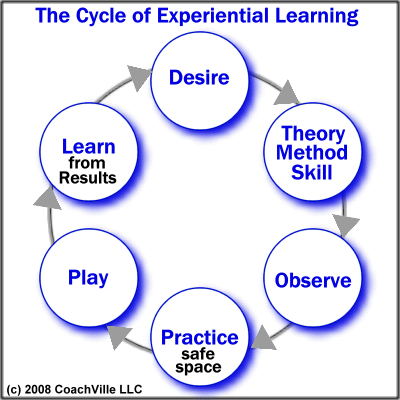Dynamic Participation is the Gateway to Mastery
Our active learning models is what sets us apart from other schools as our classes are designed around student participation and growth.
Prior to each class, the students have the opportunity to study the Theory and Method being discussed in the upcoming class. Then they listen to a recording of a live coaching session that demonstrates the method or skill. Observation is a powerful learning method as it further solidifies the method or skill.
In each class the instructor presents an idea, method or skill and students add to the dialog by presenting their ideas and experiences. The conversation is enlightening and engaging as students share and bounce ideas and thoughts off of each other, as the conversation moves forward the instructor interjects with important points and ideas in mini-lectures.
Students then move into practice of the method or skill, this is where the magic happens. In the safe space of private breakout sessions students partner with each other and coach each other using what they just learned. The instructor can “pop in” to the partner session to offer feedback and suggestions.
Our students often comment that out active learning model teaches them “real life” coaching skills. They feel ready to coach very quickly because they are sure of their abilities.
Our Active learning method in detail:
You Coach in Every Class
Coaching is a craft. And there is a definite method for learning a craft. We did not invent the method, it has been around for as long as one person has had the desire to teach another person how to do something – a very long time. We did, however – with the help of Marshall Thurber (see acknowledgments at the bottom) – apply it to the craft of coaching.
Introducing the DTMOPP Learning Method
We describe the method using the acronym DTMOPP. Which stands for Desire, Theory, Method, Observe, Practice and Play. Using this method you can become an effective Coach VERY quickly.
It works a lot like the old-fashioned apprenticeship model – without the indentured servitude (we thought it best to leave that part out!).
The elements of our DTMOPP Active Learning Method
Desire
Why do you want to learn and master this subject? How will it serve you and your life? There must be some stirring inside you that will fuel your efforts and willingness to do what it will take to master the craft.
Theory
The thinking behind the practice of the craft. This part of the process includes gathering information and studying the thoughts of teachers and practitioners of the craft.
Method
A method is a way to produce a consistent result through a sequence of actions. It is the way something is done; the thoughts, actions, tools, models and practices of the craft.
Observe
Observe others practicing the craft. Learn from what they do and do not do. Observe experienced practitioners AND novices. Notice the difference in the results that are created. As you observe you will learn and integrate the steps of the practice.
Practice
Repetition of the activities and techniques of the craft. Observe the results of your efforts. How do they compare with what you have observed? The key is to practice the right things! Practicing a method that does not produce the desired results does not lead to mastery.
Play
Play is where you put what you have practiced into the real world! Each week you will play a game that is designed to get you into your life doing what you have learned in class. You will be assigned personal growth exercises and action plans to coach at least 5 people each week. As you complete the items you earn points in the game AND share what you are learning with your coach and team mates using our Social Game System.
As you play you will get feedback as to how you are doing – the world is good that way. Feedback is the breakfast of champions. When you learn from results (or lack of results) it sparks your desire to learn more. YES! The more you play, receive feedback and adjust what you are doing, the faster you improve your skill. And earning points is really fun too.
Acknowledgement
Marshall Thurber
The year I spent mentoring with Marshall was the catalyst for the Play-Two-Win method and the DTMOPP learning method. Marshall described and used his version (called DTMIPPS) as a part of the Positive Deviant Network. Marshall is the genius behind some of the worlds most prolific personal growth gurus. Marshall kept asking me: “What is your method?” Finally, I got it. Here it is.


